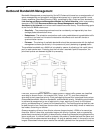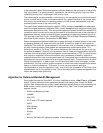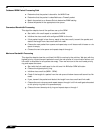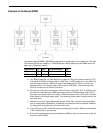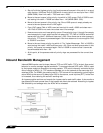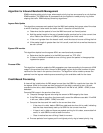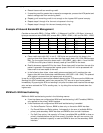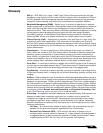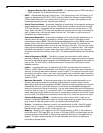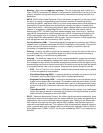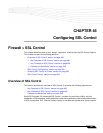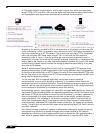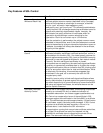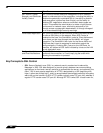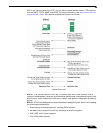
Firewall > QoS Mapping
490
SonicOS Enhanced 4.0 Administrator Guide
–
Weighted Random Early Detection (WRED) – An implementation of RED that factors
DSCP markings into its discard decision process.
• DSCP – (Differentiate Services Code Points) – The repurposing of the ToS field of an IP
header as described by RFC2747. DSCP uses 64 Code Point values to enable DiffServ
(Differentiated Services). By marking traffic according to its class, each packet can be
treated appropriately at every hop along the network.
• Global Synchronization – A potential side effect of discarding, the congestion avoidance
method designed to deal with full queues. Global Synchronization occurs when multiple
TCP flows through a congested link are dropped at the same time (as can occur in Tail
Drop). When the native TCP slow-start mechanism commences with near simultaneity for
each of these flows, the flows will again flood the link. This leads to cyclical waves of
congestion and under-utilization.
• Guaranteed Bandwidth – A declared percentage of the total available bandwidth on an
interface which will always be granted to a certain class of traffic. Applicable to both
inbound and outbound BWM. The total Guaranteed Bandwidth across all BWM rules cannot
exceed 100% of the total available bandwidth. SonicOS Enhanced 4.0 enhances the
Bandwidth Management feature to provide rate limiting functionality. You can now create
traffic policies that specify maximum rates for Layer 2, 3, or 4 network traffic. This enables
bandwidth management in cases where the primary WAN link fails over to a secondary
connection that cannot handle as much traffic. The Guaranteed Bandwidth can also be set
to 0%.
• Inbound (Ingress or IBWM) – The ability to shape the rate at which traffic enters a
particular interface. For TCP traffic, actual shaping can occur where the rate of the ingress
flow can be adjusted by delaying egress acknowledgements (ACKs) causing the sender to
slow its rate. For UDP traffic, a discard mechanism is used since UDP has no native
feedback controls.
• IntServ – Integrated Services, as defined by RFC1633. An alternative CoS system to
DiffServ, IntServ differs fundamentally from DiffServ in that it has each device request (or
reserve) its network requirements before it sends its traffic. This requires that each hop on
the network be IntServ aware, and it also requires each hop to maintain state information
for every flow. IntServ is not supported by SonicOS. The most common implementation of
IntServ is RSVP.
• Maximum Bandwidth – A declared percentage of the total available bandwidth on an
interface defining the maximum bandwidth to be allowed to a certain class of traffic.
Applicable to both inbound and outbound BWM. Used as a throttling mechanism to specify
a bandwidth rate limit. SonicOS Enhanced 4.0 enhances the Bandwidth Management
feature to provide rate limiting functionality. You can now create traffic policies that specify
maximum rates for Layer 2, 3, or 4 network traffic. This enables bandwidth management in
cases where the primary WAN link fails over to a secondary connection that cannot handle
as much traffic.The Maxmimum Bandwidth can be set to 0%, which will prevent all traffic.
• Outbound (Egress or OBWM) – Conditioning the rate at which traffic is sent out an
interface. Outbound BWM uses a credit (or token) based queuing system with 8 priority
rings to service different types of traffic, as classified by Access Rules.
• Priority – An additional dimension used in the classification of traffic. SonicOS uses 8
priority rings (0 = highest, 7 = lowest) to comprise the queue structure used for BWM.
Queues are serviced in the order of their priority ring.
• Mapping – Mapping, with regard to SonicOS’ implementation of QoS, is the practice of
converting layer 2 CoS tags (802.1p) to layer 3 CoS tags (DSCP) and back again for the
purpose as preserving the 802.1p tags across network links that do not support 802.1p
tagging. The map correspondence is fully user-definable, and the act of mapping is
controlled by Access Rules.



